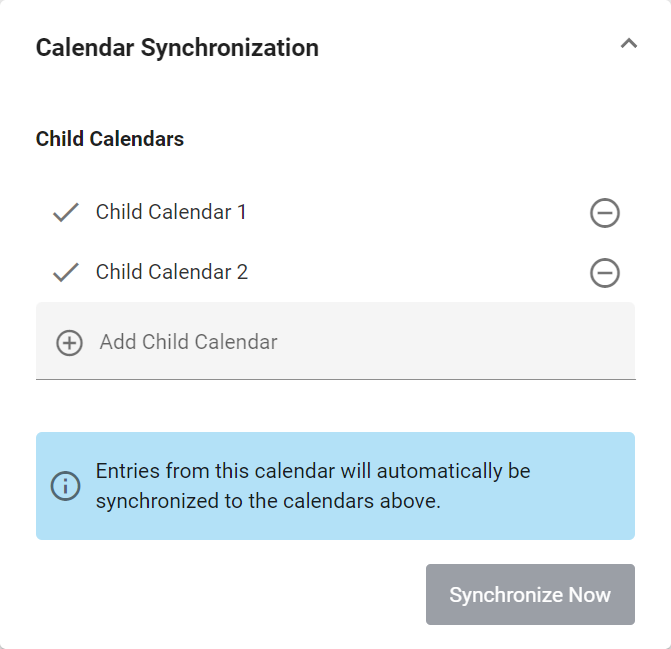Link BACnet calendars and schedules
You can assign several calendar or schedule objects to the same main calendar or schedule and have events from the main calendar or schedule automatically synchronize to the other calendars or schedules, respectively.
Before you can link BACnet calendars or schedules, they have to be available as data points. See Reconcile BACnet objects to learn more about it.
Once the data points are available, select your main calendar or schedule in the data point list. On the data point details page, scroll down to the Calendar Synchronization or Schedule Synchronization card. Leave the field Main Calendar (or Main Schedule) empty, as the current data point is the main calendar or schedule. Instead, click on Add Child Calendar (or Add Child Schedule) and select a calendar or schedule from the dropdown. As soon as you select a child calendar or schedule, the Main Calendar or Main Schedule field will disappear. You can assign as many child calendars or schedules as you want. Save your changes by clicking on Save at the top right.

After saving the changes, the system will attempt to synchronize the events from the current calendar or schedule object to the child calendars or schedules. The status will be displayed next to the child calendar or schedule:
Synchronization is pending |
|
Synchronization was successful |
Warning
The synchronization status is not updated automatically. To update the status, please refresh the page.
You can also start a manual synchronization by clicking on Synchronize Now.
To remove a child calendar or schedule, click on Remove next to the child calendar or schedule and then on Save at the top right.
If you go to the data point details page of any of the child calendars or schedules, you’ll see that the main calendar or schedule is set in the Main Calendar or Main Schedule field, respectively. You can remove or change the main calendar or schedule here, which will automatically remove the calendar or schedule from the previous main calendar or schedule and add it to the new one.
Note
A calendar or schedule can either be a main calendar or schedule or a child calendar or schedule, respectively, but never both at the same time.
When are calendars or schedules synchronized
Events from a main calendar or schedule are synchronized to its child calendars or schedules when a child calendar or schedule is added to a main calendar or schedule, when the main calendar or schedule or any of its events are edited or when the user triggers a manual synchronization.
During synchronization, any manual changes that were made to the events of child calendars or schedule will be reverted, and the child calendars or schedules will mirror the events of their main calendar or main schedule, respectively.